The Dorset and East Devon Coast is also called the Jurassic Coast. The Jurassic Coast stretches 155 km along the southwestern coast of England, from Orcombe Point in East Devon to Old Harry Rocks in Dorset. The landscape of the Jurassic Coast provides insight into the natural processes that have shaped the Earth and how life has evolved during evolution. The Jurassic Coast spans 185 million years of the geological history of the Earth, the rocks along the coast preserve the fossils of the creaturs such as marine reptiles and dinosaurs that once lived here. Today, fossils still can be found. The Jurassic Coast is an important fossil site in Europe, two other important fossil sites in Europe are: the Messel Pit and the Monte San Giorgio. The Jurassic Coast also includes interesting landforms, natural rock arches, coves and sea stacks, among the most famous are Lulworth Cove and Durdle Door, formed by sea erosion. The Lulworth Crumple are layers of rock formed by the collision of the continents millions of years ago, the Alps also arose as the result of this collision. The cliffs along the coast are formed of sandstone, limestone, Jurassic clay and shale. Some of the most amazing and interesting locations of the Jurassic Coast are: Durdle Door, Lulworth Cove, the Lulworth Fossil Forest, Man O' War Cove, Portland Bill and Pulpit Rock on the Isle of Portland, the Cliffs at Bowleaze Cove, the Red cliffs of Sidmouth, Chesil Beach and the Devon Cliffs of Exmouth. The Dorset and East Devon Coast gained the status as a UNESCO World Heritage in 2001. The Dorset and East Devon Coast is the first natural UNESCO World Heritage Site in England.
www.werelderfgoedfotos.nl © Copyright World Heritage Photos Classic Car Road Trip
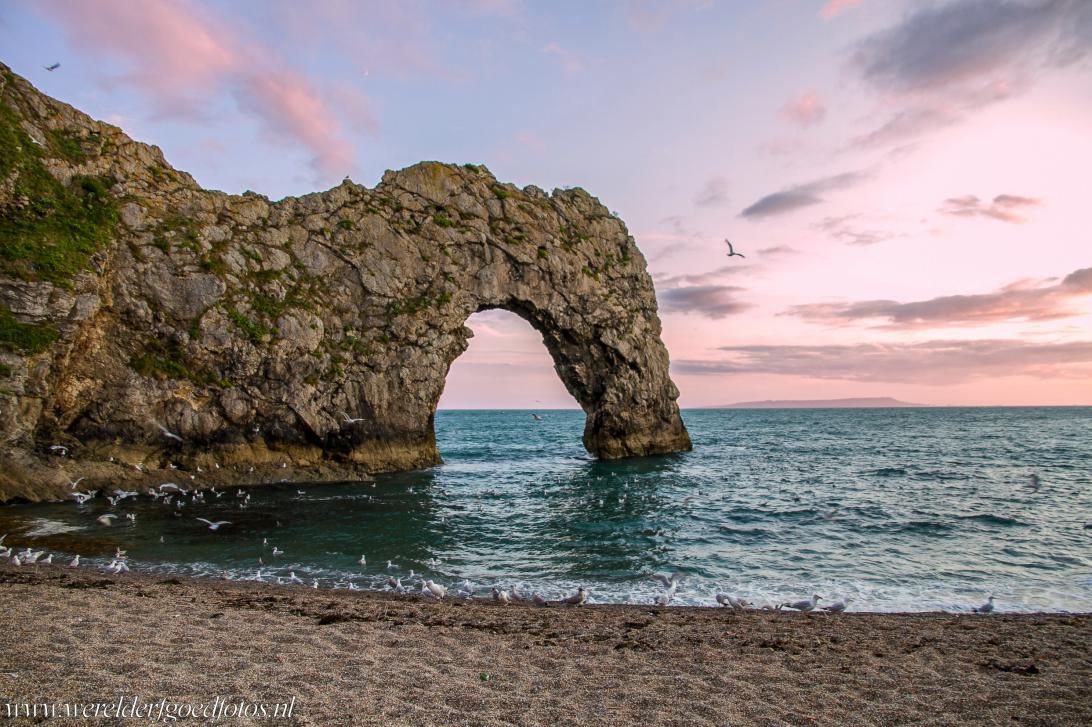
The Dorset and East Devon Coast: The iconic Durdle Door at nightfall. Durdle Door is a natural limestone arch, it was formed by wave erosion as the waves of the sea constantly undercut the cliff at its base, a slow and gradual process of millions of years. Durdle Door is situated close to the tiny village of West Lulworth.

The Dorset and East Devon Coast: The iconic Durdle Door at nightfall. Durdle Door is a natural limestone arch, it was formed by wave erosion as the waves of the sea constantly undercut the cliff at its base, a slow and gradual process of millions of years. Durdle Door is situated close to the tiny village of West Lulworth.
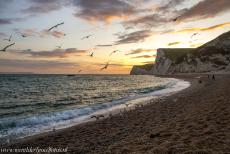
The Dorset and East Devon Coast, also known as the Jurassic Coast. The Jurassic Coast stretches with a total length of 155 km along the southwest coast of England, from Orcombe Point in East Devon to the Old Harry Rocks in Dorset. The landscape of the Jurassic Coast offers insight into the natural processes that have shaped the Earth and how life has evolved during evolution.
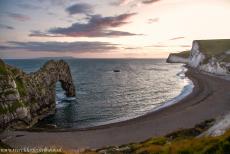
The Dorset and East Devon Coast: Nightfall at Durdle Door, viewed from the South West Coast Path. Together with Lulworth Cove, Durdle Door is among the most iconic geological features on the Dorset and East Devon Coast and one of the most famous natural stone arches in the world. The Dorset and East Devon Coast were inscribed on the UNESCO World Heritage in List 2001.
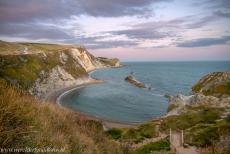
The Dorset and East Devon Coast: The Man O' War Cove at sunset, viewed from the South West Coast Path. The Man O' War Cove is a small bay and part of a larger bay, called St. Oswald's Bay. The coastal promontory Dungy Head forms the eastern end of St. Oswald's Bay. The rocks in the bay are called the Man O' War Rocks. Durdle Door is situated at the western side of the cove.
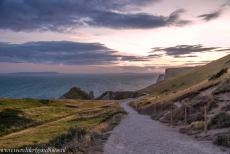
The Dorset and East Devon Coast, also the Jurassic Coast: The section of the South West Coast Path between Lulworth Cove and Durdle Door, the Isle of Portland can be seen on the horizon. The cliffs along the coast are formed of sandstone, limestone, Jurassic clay and shale. The South West Coast Path is a long distance trail, running from Minehead in Somerset to Poole Harbour in Dorset.
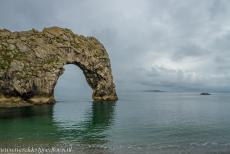
The Dorset and East Devon Coast: The iconic natural rock arch of Durdle Door at high tide on a misty morning. The Dorset and East Devon Coast also includes other interesting landforms such as natural rock arches, coves and sea stacks, formed by sea erosion. The most renowned among them are Lulworth Cove and Durdle Door.
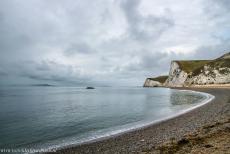
The Dorset and East Devon Coast is also called the Jurassic Coast. The Jurassic Coast spans 185 million years of the geological history of the Earth, the rocks along the coast preserve the fossils of creatures such as marine reptiles and dinosaurs that once lived here. Now, fossils still can be found along the Jurassic Coast. The most famous fossil collector on the Jurassic Coast was Mary Anning, fossils she discovered are housed in the Lyme Regis Philpot Museum.
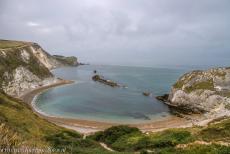
The Dorset and East Devon Coast, the Jurassic Coast: The Man O' War Cove at daybreak, viewed from the South West Coast Path. Dungy Head is a coastal promontory between the Man O' War Cove and Lulworth Cove. The area east of Lulworth Cove contains a fossil forest, the remains of a forest which grew here about 145 million years ago. The Dorset and East Devon Coast gained the status as a UNESCO World Heritage in 2001.
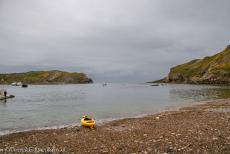
Dorset and East Devon Coast: Lulworth Cove is a small natural bay close to the village of West Lulworth in Dorset. The almost circular bay has a narrow opening to the sea, it was formed by sea erosion, the sea has broken through the coastline of the Portland limestone rock layer and eroded the clay behind it. The bay is one of the best examples of such a landform in the world. The horseshoe shaped Lulworth Cove is believed to be shaped about 10,000 years ago.
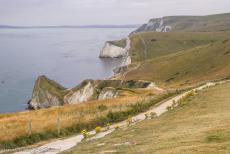
The Dorset and East Devon Coast: Lulworth Cove is surrounded by the Lulworth Crumple, layers of rock formed by the collision of the continents of Africa and Europe millions of years ago, the Alps also arose as the result of this collision. The rocks of the Lulworth Crumple are twisted and folded in a spectacular way (the rock on the left hand side).
